Long sitting can affect the mobility of your upper back and weaken the back muscles. That’s why it’s important to exercise and strengthen your back muscles. This back workout with a dumbbell will help you do that.
Strengthening your back muscles—the lats, rhomboids, and traps—gives you aesthetic physic and helps improve muscle imbalances and posture.
Like you, I think dumbbell exercises would be a good addition to your home back workout routine.
- Dumbbells require more balance than barbells or machines, which can lead to greater muscle fiber recruitment.
- They allow unilateral training (training one limb at a time), increase core stability, and improve muscular imbalances.
- It allows for greater joint safety and stabilization and allows the joints to move naturally within their range of motion.
- Perfect for at-home exercises with limited space.
Let’s build serious back muscle and strength with just a pair of dumbbells.
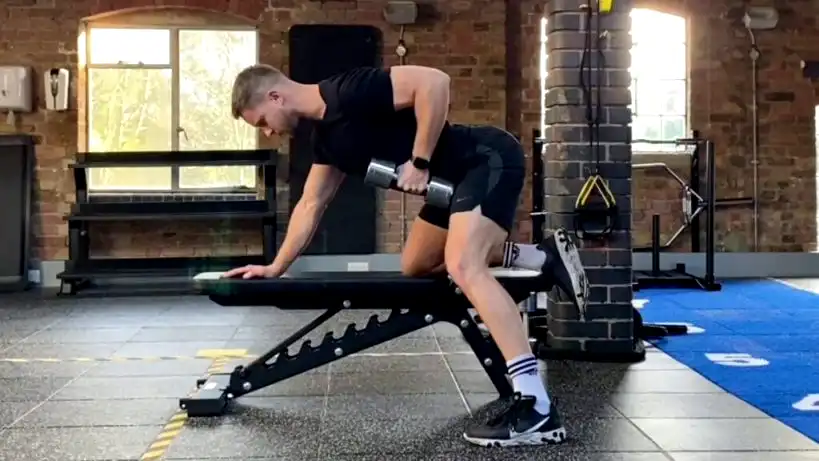
- Back Muscles (Anatomy)
- Dumbbell Back Exercises For Home Without Bench
- 1. One-Arm Dumbbell Row
- 2. Dumbbell Deadlift
- 3. Dumbbell Upright Row
- 4. Dumbbell Bent Over Row
- 5. Renegade Row
- 6. Dumbbell Farmers Walk
- 7. Bent Over Dumbbell Lateral Raise
- How To Train Upper, Middle and Lower Back With Dumbbell At Home
- Dumbbell Back Training Tips (With Workout Routines)
- 1. Tips and Techniques
- 2. Training Plan As Per Your Goal
- 3. Beginner Friendly Back Workout Routine At Home
- 4. Back Workout At Home With Single Dumbbell
- 5. Dumbbell Back Workout Without Bench
- FAQs
- Lower back workout at home with dumbbells
- Lats workout at home with dumbbells
- How many sets and reps should I do for each exercise?
- Can I get an effective back workout at home using dumbbells?
- How long should a typical dumbbell back workout last?
- Can I achieve a V-shaped back with dumbbell exercises alone?
- Conclusion
- 7 Best Dumbbell Back Exercises At Home Without a Bench
Back Muscles (Anatomy)
To build a strong and muscular back at home, you must first understand the anatomy and functionality of the back muscles. Your back muscles start just under your skull and down to your lower back, just above your hips. These muscles connect to your ribs, vertebrae, shoulder blades, and neck.
Your back comprises three groups of muscles: Superficial Muscles, Intermediate Muscles, and Intrinsic Muscles.
Superficial Muscles are closer to the skin’s surface and comprise the upper and lower back muscles. Includes:
- Latissimus dorsi (lats): large muscles that extend from the middle and lower back to the armpits
- Rhomboids: Located between the shoulder blades. They run from the medial border of the scapula (shoulder blade) to the spine.
- Trapezius (traps): Large, triangular muscle extending from the skull’s base to the mid-back.
- Levator scapulae: Located on the side and back of the neck. It runs from the upper cervical vertebrae to the upper border of the scapula (shoulder blade)
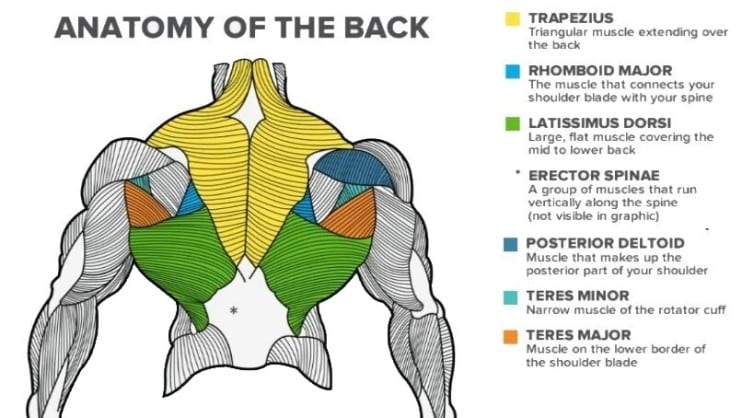
Dumbbell Back Exercises For Home Without Bench
The back workout at home with a dumbbell is divided into dumbbell rowing exercises, Deadlifts, Dumbbell pullovers, and low-back exercises.
Adding dumbbell exercises into your routine will help you build back muscle and strength, as well as help you build thickness in between your shoulder blades and upper back.
1. One-Arm Dumbbell Row
One-Arm Dumbbell Row is an excellent full-range exercise to build the lat muscles. This helps to work on each side independently, thereby providing better muscle isolation and a longer range of motion.
It is an excellent alternative to the barbell rows. This exercise is performed with a single dumbbell with your body supported by a bench.
If the bench is not available at home, You can use a chair or table for support while doing the one-arm dumbbell row.
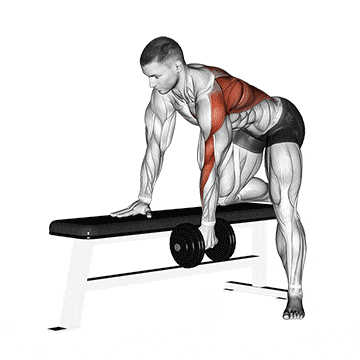
How To Do
- Hold a dumbbell with your palm facing inward.
- Place the opposite hand and knee on a bench, keeping your spine straight and your body just above parallel to the floor.
- Pull the dumbbell vertically upward alongside your torso, raising the elbow as high as possible.
- Keep motion under strict control for better isolation.
- Slowly lower the dumbbell as low as possible, feeling a good lats spread.
- It is important to avoid hunchback bending, as it can lead to injury.
- Repeat on the other side.
2. Dumbbell Deadlift
The dumbbell deadlift is the best variation of the classic barbell deadlift. It is a powerful exercise that builds an overall body by using more muscles than any other exercise.
It is the best exercise for strengthening the posterior chain muscle, which includes the erector spine, glutes, and hamstrings.
If you were looking for one exercise you could do at home to work your whole body, including your lower back, upper back, triceps, legs, and buttocks, I would recommend the dumbbell deadlift.
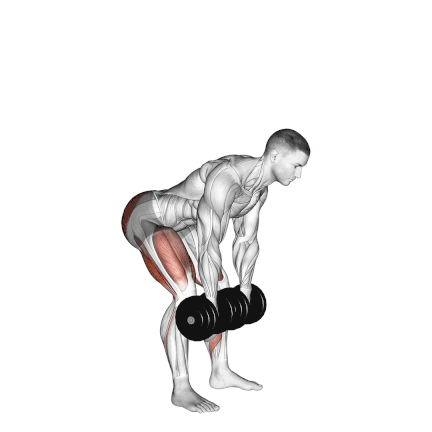
How To Do
- Place a dumbbell in front of your body. Grab the Dumbbells with each of your hands.
- Remember to keep your back as straight as possible and tighten your back and hamstring muscles.
- Lift the dumbbell from the ground using your hamstring and glute muscles.
- You should maintain a straight back and slightly bent legs, with your head looking upwards.
- Raise it to the point where your body is erect. Do not hyperextend your body as the weight shifts to the lumbar spine.
- Hold the dumbbell for a moment at the top of the lift.
- Now, slowly lower the dumbbell at a steady, slow pace by bending at the hips first and then at the knees, letting the weight almost touch the ground for a moment before you begin the next rep.
- Do not go through half of the exercise; complete the lift.
- Avoid jerky movements and keep motion controlled.
3. Dumbbell Upright Row
The dumbbell upright row is a compound exercise that targets your deltoids (shoulders) and traps (upper back) and biceps.
Although it’s a simple move, it’s very easy to get wrong. Mastering the technique is important for building muscle on your traps.
Upright Rows can be done with both narrow grips and wider ones.
- The narrow grip focuses on traps,
- The wider focus is on the entire shoulder girdle (Best Option).
- Furthermore, the wider grip allows for some cheating movement, which allows you to lift more weight.
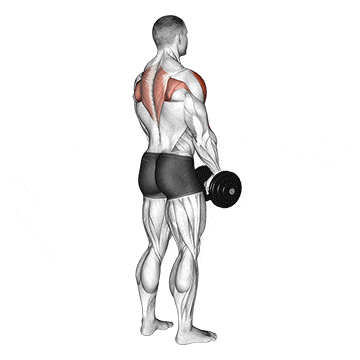
How To Do
- Hold a dumbbell with an overhand grip and allow it to hang in front of you. Keep your back straight.
- Lift the dumbbell, use your arms to get it as close as possible to the chin, and elevate your shoulders to squeeze your trapezius muscles.
- Now, lower the dumbbell under controlled motion until it returns to its starting position.
- Remember to breathe out when you work hard.
- Keep a controlled motion and avoid jerky movements
4. Dumbbell Bent Over Row
If you are looking to strengthen your back and add massive muscle to the upper back region, bent-over dumbbell rows are the exercise for you.
It targets upper, middle, and lower back muscles, including the trapezius, infraspinatus, rhomboids, latissimus dorsi, teres major, and teres minor.
- Pulling the dumbbell up toward the chest targets the upper latissimus and trapezius.
- Pulling the dumbbell through a lower trajectory to touch the abdomen targets the lower lats.
You only need a pair of dumbbells and a bit of space to do this exercise.
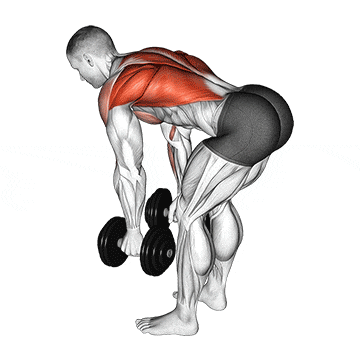
How To Do
- Take a narrow stance and hold two dumbbells with a neutral grip in each hand.
- Bend your torso forward at an angle of 45 degrees to the floor with your knees slightly bent.
- Make sure you are not using more weight than you can handle.
- Now, use the back and raise the dumbbell until it touches the abdominal region and not the chest region, as it reduces back muscle contraction.
- Keep your body straight from your shoulders to your ankles as you row the weight.
- Slowly lower the dumbbell, keeping it in control to the starting position.
5. Renegade Row
Renegade rows are full-body exercises that simultaneously activate core muscles like the obliques, back muscles like the rhomboids, and arm muscles like the triceps.
It is an exercise that tones your back and works your core, while also testing your balance and stability.
It is the ultimate form of functional strength training you can easily do with dumbbells at home.
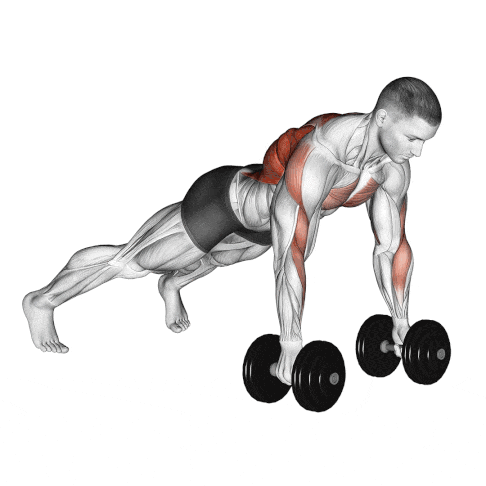
How To Do
- Place two dumbbells on the floor about shoulder-width apart.
- Start in the top position of a push-up position with your hands on the weights.
- Keep your body straight from your shoulders to your ankles as you row the weight.
- Pull your right elbow back, raising the dumbbell toward your chest. Keep your right elbow close to your torso, your abs tight, and your hips in one line.
- Hold for one second at the top and then slowly return the weight to the starting position to repeat on the other side.
- Complete the desired number of repetitions.
- Make sure you complete the same number of repetitions for each arm.
6. Dumbbell Farmers Walk
The farmer’s walk exercise also called the farmer’s carry, is a strength and conditioning exercise.
It is a simple exercise that enhances grip and core strength, balance and coordination, posture, and overall total body strength.
During a farmer’s carry workout, you hold a dumbbell in each hand while walking for a designated distance. It’s a classic move that men have been doing since the beginning of time.
It allows you to accomplish a tremendous amount in a single exercise. This exercise should be part of your home workout routine to build a strong and impressive back.
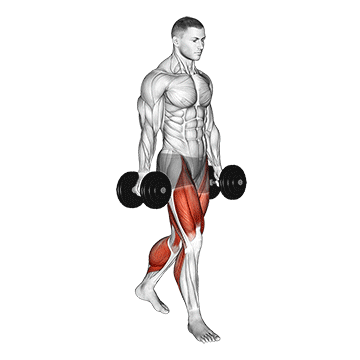
How To Do
- Deadlift a pair of dumbbells from the floor. Bend at the hips and knees and reach down to grasp the dumbbells in each hand.
- Hold the dumbbells at your side with a firm grip. Stand tall, keeping your shoulders, back, and core tight.
- Take small, steady steps, and walk forward at an even pace with your eyes focused straight ahead.
- Complete the desired number of steps, come to a stop, and place the dumbbells while keeping a tight core and neutral spine.
- Focus on squeezing your shoulder blades and tightening your abs.
- Keep a neutral or straight spine throughout the movement to avoid injury.
7. Bent Over Dumbbell Lateral Raise
Bent over dumbbell raise exercise is an excellent exercise to work on rear deltoid and back muscles.
The bent-over raise is a must for complete shoulder and back muscle development. Thus, this exercise targets specifically the rear shoulder, head, and middle and lower Trapezius, Infraspinatus, Teres Minor.
This exercise can be performed in both a standing or a seated position. It is one of the best dumbbell exercises for building a stronger upper body. Add it to your at-home back workout regime.
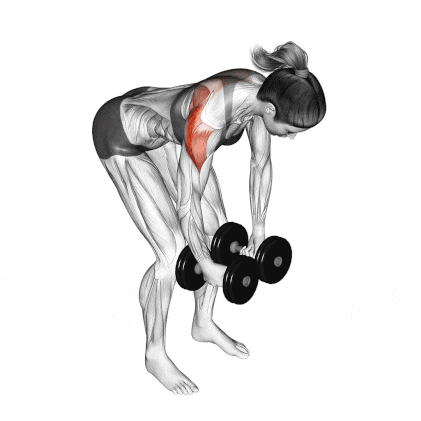
How To Do
- Stand with your feet shoulder-width apart and a slight bend in your knees.
- Hold a dumbbell in each hand with a neutral grip (palms facing each other).
- Hinge at your hips while maintaining a straight back and slightly bend forward.
- Your upper body should be almost parallel to the floor.
- Keep your head neutral, looking down towards the floor to maintain a straight spine.
- Engage your core to stabilize your body throughout the movement.
- With a slight bend in your elbows, raise both arms out to the sides in a controlled motion.
- Keep raising your arms until they align with your shoulders, forming a “T” shape with your body.
- At the top of the movement, squeeze your shoulder blades together to engage the rear deltoids fully.
How To Train Upper, Middle and Lower Back With Dumbbell At Home
A good back training routine at home should include various exercises that work all the majors back muscles.
To get a complete back workout and to build balanced strength, you need to do various back exercises to target your trapezius, upper, middle and lower back muscles.
- Upright rows and dumbbell shrugs are great exercises for building the upper back, including trap muscles, at home without a bench.
- Middle back exercises target the mid and lower trap, rhomboids, and lats. When choosing dumbbell exercises for your middle back, you should include a variety of row exercises, such as dumbbell bent over rows and One arm row.
- For lower back exercises at home, you can do the dumbbell deadlift and Renegade Row.
This dumbbell training routine for the back is designed to increase strength and muscle mass. However, the gains will be increased with the use of primary lifts like deadlifts and bent-over Rows.
Dumbbell Back Training Tips (With Workout Routines)
1. Tips and Techniques
- Warm up before you start your workout.
- Focus on proper form.
- Concentrate on the targeted muscles during the exercises to maximize their activation.
- Use a weight that is challenging but not too heavy.
- Utilize a full range of motion during exercises
- Engage your core muscles.
- Breathe deeply and evenly throughout the workout.
- Cool down after your workout.
- Allow adequate rest between workouts to allow the muscles to recover and grow.
- Pay attention to rest days and avoid overtraining to prevent fatigue and injuries.
2. Training Plan As Per Your Goal
- For muscle endurance: Aim for 3-4 sets of 12-15 reps, with a moderate amount of resistance.
- For muscle strength: Aim for 3-5 sets of 6-10 reps, with a heavier amount of resistance.
- For muscle hypertrophy (increased muscle size): Aim for 3-4 sets of 8-12 reps, with a moderate to heavy amount of resistance.
It is always best to start with a lower number of reps and sets, and then gradually increase as your strength improves.
3. Beginner Friendly Back Workout Routine At Home
| Exercise | Sets | Reps |
|---|---|---|
| One-Arm Dumbbell Row | 3 | 8-10 |
| Dumbbell Upright Row | 3 | 10-12 |
| Dumbbell Farmers Walk | 4 | 10-20 sec |
| Bent Over Dumbbell Lateral Raise | 4 | 10-12 |
4. Back Workout At Home With Single Dumbbell
| Exercise | Sets | Reps |
|---|---|---|
| One-Arm Dumbbell Row | 3 | 10-12 |
| Single Arm Deadlift | 3 | 8-10 |
| Single Arm Reverse Fly | 4 | 10-12 |
| Dumbbell Pullovers | 4 | 10-12 |
5. Dumbbell Back Workout Without Bench
| Exercise | Sets | Reps |
|---|---|---|
| Dumbbell Deadlift | 4 | 8-10 |
| Dumbbell Bent Over Row | 3 | 10-12 |
| Dumbbell Farmers Walk | 3 | 10-20 sec |
| Dumbbell Upright Row | 3 | 8-10 |
FAQs
Lower back workout at home with dumbbells
- Bent-Over Dumbbell Rows
- Dumbbell Romanian Deadlifts (RDLs)
- Good Mornings with Dumbbells
- Bird Dogs with Dumbbells
- Dumbbell Side Bends (for obliques and lower back)
Lats workout at home with dumbbells
These exercises will help to build and strengthen your lats, which are the large muscles that run along the sides of your back.
- Dumbbell rows
- Dumbbell pullovers
- Dumbbell pull-ups
- Dumbbell seated rows
- Dumbbell bent-over rows
- Dumbbell reverse fly
- Dumbbell single-arm rows
How many sets and reps should I do for each exercise?
A good starting point is to do 3 sets of 8–12 repetitions for each exercise. As you get stronger, you can gradually increase the number of sets and repetitions.
Can I get an effective back workout at home using dumbbells?
Absolutely! Dumbbells are versatile and effective tools for targeting your back muscles at home. You can get big results and build a stronger back with the right exercises and proper form.
How long should a typical dumbbell back workout last?
A typical dumbbell back workout can take 30 to 60 minutes, depending on the number of exercises and sets and reps. Focus on quality over quantity to ensure effective muscle engagement.
Can I achieve a V-shaped back with dumbbell exercises alone?
Dumbbell exercises can significantly contribute to developing a V-shaped back, especially when combined with a well-rounded workout routine and proper nutrition.
Conclusion
These dumbbell exercises without a bench are highly recommended for anyone interested in building a wider back and wanting to gain strength at home.
It not only helps build muscle in a specific area, but also makes the back look bigger overall. There is no fancy equipment or scientific details required for this exercise.
Please keep in mind that there are other types of exercises you can do. Get the benefits they offer and use other back exercises to supplement them when needed.
Dumbbell exercises can be easily incorporated into your home training program and can be particularly effective when used alongside barbell and bodyweight exercises to build a strong, robust back.
Please let us know, in the comment section below, your favorite exercises! Thanks.
Stay Fit, Live a Happy and Healthy Life
7 Best Dumbbell Back Exercises At Home Without a Bench

Manish brings over 10 years of hands-on experience in weight lifting and fat loss to fitness coaching. He specializes in gym-based training and has a lot of knowledge about exercise, lifting technique, biomechanics, and more.
Through “Fit Life Regime,” he generously shares the insights he’s gained over a decade in the field. His goal is to equip others with the knowledge to start their own fitness journey.
